翻译技巧之语序调整法
英语六级翻译技巧:语序的调整
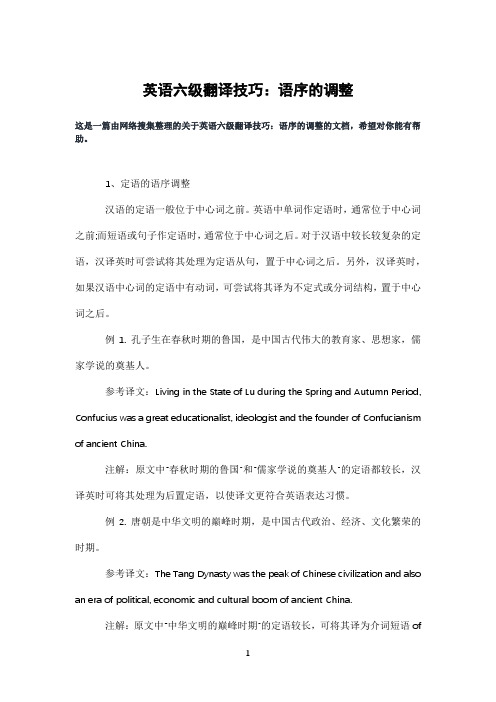
英语六级翻译技巧:语序的调整这是一篇由网络搜集整理的关于英语六级翻译技巧:语序的调整的文档,希望对你能有帮助。
1、定语的语序调整汉语的定语一般位于中心词之前。
英语中单词作定语时,通常位于中心词之前;而短语或句子作定语时,通常位于中心词之后。
对于汉语中较长较复杂的定语,汉译英时可尝试将其处理为定语从句,置于中心词之后。
另外,汉译英时,如果汉语中心词的定语中有动词,可尝试将其译为不定式或分词结构,置于中心词之后。
例1. 孔子生在春秋时期的鲁国,是中国古代伟大的教育家、思想家,儒家学说的奠基人。
参考译文:Living in the State of Lu during the Spring and Autumn Period, Confucius was a great educationalist, ideologist and the founder of Confucianism of ancient China.注解:原文中“春秋时期的鲁国”和“儒家学说的奠基人”的定语都较长,汉译英时可将其处理为后置定语,以使译文更符合英语表达习惯。
例2. 唐朝是中华文明的巅峰时期,是中国古代政治、经济、文化繁荣的时期。
参考译文:The Tang Dynasty was the peak of Chinese civilization and also an era of political, economic and cultural boom of ancient China.注解:原文中“中华文明的巅峰时期”的定语较长,可将其译为介词短语ofChinese civilization,置于中心词之后。
同样,“中国古代政治、经济、文化繁荣的时期”的定语也较长,可将其译为介词短语of political, economic and cultural boom of ancient China,作后置定语。
例3. 京剧是结合了音乐、表演、文学、脸谱的艺术形式。
英汉互译中语序的调整

汉语的连动句或称施事句的英译首先要从汉语各动 词的时间或事理排列顺序中看清它们之间的关系和 性质,进而确定一个或几个S-V主干,以便英语断 句,而后调动英语的各种连接手段把汉语中采用的 动词转换成各类英语的短语或从句,打破汉语句子 的时间或事理顺序,适当地挂连在各个主干上。比 如:
6)紫鹃答应着,忙出来换了一个痰盆儿,将手里的 这个盆儿放在桌子上,开了套间门出来,仍旧带上 门,放下撒花软帘,出来叫醒雪雁。(曹雪芹((红楼 梦》)。 Zijuan, assenting, hurried out to fetch and clean spittoon,placing the used one on the table in the outer room. Having closed the door behind her, she let down the soft flowered portiere(门帘) before going to wake Xueyan.
widow and widower ourselves and the enemy
food, clothing and housing
衣、食、住
Have ample food and clothing(be well-fed and well-clothed) 丰衣足食 Quick of eye and deft of hand 眼疾手快 in twos and threes 三三两两 Face the world and brave the storm 经风雨,见世面 elementary and high school 中小学
4)我们上星期天在她家尽情地吃了一顿, We ate to our hearts' content at her home last Sunday.
语序调整翻译法
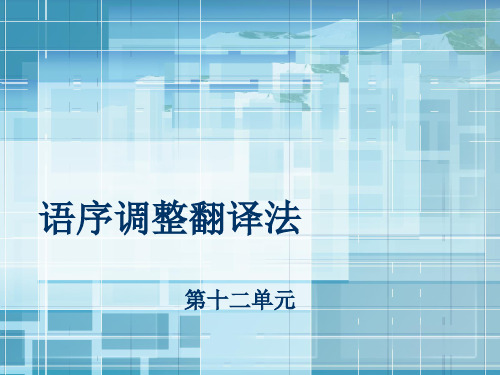
英汉两者语言在词序上的差异
• 3)定语的词序差异: • 英语中,定语的位置灵活多变,可置于被修饰名 词之前或之后,还可同时置于被修饰词的之前和 之后。 • 汉语中,定语则通常只能位于被修饰的名词之前。 Traditional Chinese virtue • 例如排序差异: 中华传统美德 • 英:限定词 - 描绘词 - 大小新旧 - 颜色 - 类别 + 中 心名词 • 汉:邻属关系 - 时间处所 - 指示代词或量词 - 动词 性词语和主谓短语 - 形容词性词语 + 性质类别或 范围的名词、动词
• • • • • 一是扼要你出全句的轮廓; 二是要根据上下文和全句的内容领会要旨; 三是要辨清全句的主从结构; 四是要找出各句之间从属关系。 找出句子主句 找出主句中的主谓语,了解 中心思想 理清主句与从句,主要成分与次 要成分, 修饰与被修饰等各层次关系和内容 按照逻辑顺序把句子的各个部分内容串成 一个完整的话语。
例析1
• International countertrade (对等/对销/反向贸 易) is a practice whereby a supplier commits contractually – as a condition of sale – to reciprocate(回报) and undertake certain specified commercial initiatives(商务提案) that compensate and benefit the buyer. • 国际对销贸易,作为一种销售条件,是指供 应方以合同的方式 承诺对某些特别的、给购 买方以补偿和利益的商务提案予以回报和承 办的一种做法。
长句的翻译
长句翻译的要点
• 长句是指语法结构比较复杂、从句和修饰 语较多,包含的内容层次在一个以上的句 子 • 对于长句的翻译,有两点至关重要:一是 对原文的准确理解;二是在译文当中恰如 其分的表达。
英语翻译技巧中的语序调整法探析

英语翻译技巧中的语序调整法探析在英语翻译中,语序调整是一项非常重要的技巧。
语序调整不仅有助于翻译者更好地理解原文意思,还可以使翻译结果更加地通顺自然。
下面,我们将结合实例,探究英语翻译中常用的语序调整法。
一、倒装法倒装法是一种常见的语序调整方法,主要是为了强调句子中的某一部分内容。
在倒装法中,一般情况下是把谓语动词放在主语之前,也可以倒装其他成分,如状语、介词短语等。
比如:1.原句:He spoke and walked away.翻译:他说完就走了。
2.原句:The boy was playing with the ball in the garden when his mother called him.翻译:孩子在花园里玩球,他妈妈叫他的时候。
二、强调句强调句是一种特殊的句子结构,通过调整语序,使某一句子成分或成分组获得强调效果。
在强调句中,通常用it来引导句子,然后再用动词to be或助动词do/does/did来强调被强调的部分。
翻译:我昨天见到了约翰。
强调句:It was John that I met yesterday.翻译:她英语讲得很好。
三、省略句式在英语中,一些句子成分可以省略,但在翻译时需要补充上去。
这种省略句式在语序调整中也是非常常见的。
翻译:他们宁愿呆在家里也不愿去电影院。
省略“can”的句子:I can’t speak French as well as you.总之,在英语翻译中,语序调整是非常常用的一种技巧。
在掌握了一定的语言基础后,熟练掌握这种技巧可以让你的翻译更加流畅、自然。
汉译英之语序调整
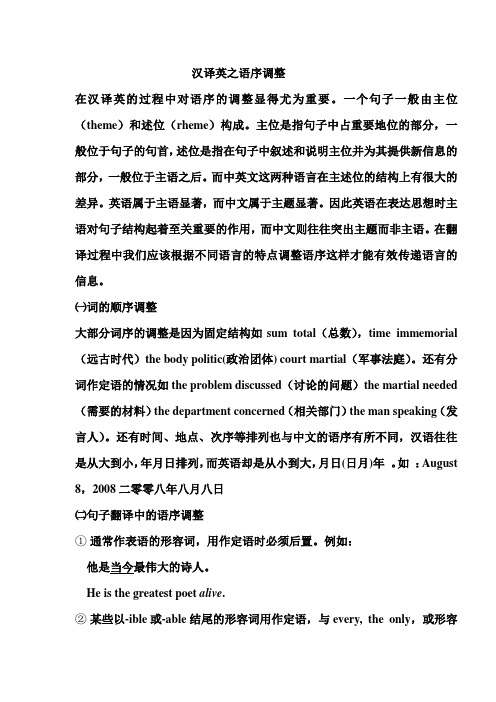
汉译英之语序调整在汉译英的过程中对语序的调整显得尤为重要。
一个句子一般由主位(theme)和述位(rheme)构成。
主位是指句子中占重要地位的部分,一般位于句子的句首,述位是指在句子中叙述和说明主位并为其提供新信息的部分,一般位于主语之后。
而中英文这两种语言在主述位的结构上有很大的差异。
英语属于主语显著,而中文属于主题显著。
因此英语在表达思想时主语对句子结构起着至关重要的作用,而中文则往往突出主题而非主语。
在翻译过程中我们应该根据不同语言的特点调整语序这样才能有效传递语言的信息。
㈠词的顺序调整大部分词序的调整是因为固定结构如sum total(总数),time immemorial (远古时代)the body politic(政治团体) court martial(军事法庭)。
还有分词作定语的情况如the problem discussed(讨论的问题)the martial needed (需要的材料)the department concerned(相关部门)the man speaking(发言人)。
还有时间、地点、次序等排列也与中文的语序有所不同,汉语往往是从大到小,年月日排列,而英语却是从小到大,月日(日月)年。
如:August 8,2008二零零八年八月八日㈡句子翻译中的语序调整①通常作表语的形容词,用作定语时必须后置。
例如:他是当今最伟大的诗人。
He is the greatest poet alive.②某些以-ible或-able结尾的形容词用作定语,与every, the only,或形容词最高级连用来修饰一个名词时,也常放在所修饰的名词之后。
例如这是这儿能找到的唯一参考书This is the only reference book available here.③某些分词用作定语时,也须后置。
例如他们收下了赠送的礼物,十分高兴。
They were very glad to have accepted the presents offered.④某些表示位置、方向的副词用作定语时,也可放在所修饰的名词之后这儿的书很好看。
翻译资格考试备考:英汉翻译技巧之语序的调整
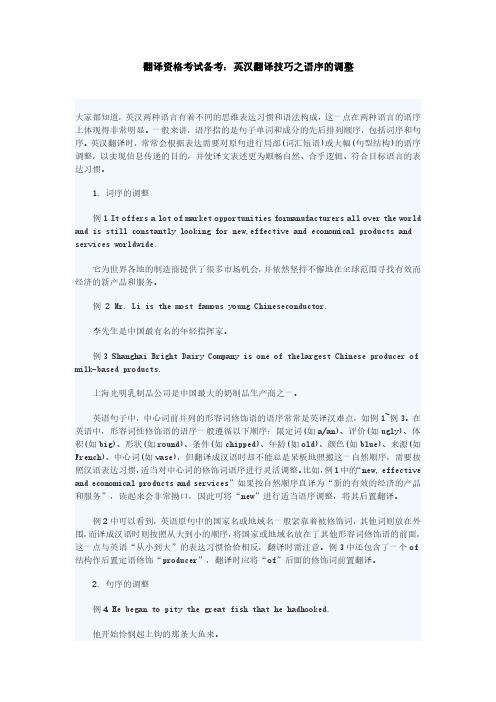
翻译资格考试备考:英汉翻译技巧之语序的调整大家都知道,英汉两种语言有着不同的思维表达习惯和语法构成,这一点在两种语言的语序上体现得非常明显。
一般来讲,语序指的是句子单词和成分的先后排列顺序,包括词序和句序。
英汉翻译时,常常会根据表达需要对原句进行局部(词汇短语)或大幅(句型结构)的语序调整,以实现信息传递的目的,并使译文表述更为顺畅自然、合乎逻辑、符合目标语言的表达习惯。
1.词序的调整例1It offers a lot of market opportunities formanufacturers all over the world and is still constantly looking for new,effective and economical products and services worldwide.它为世界各地的制造商提供了很多市场机会,并依然坚持不懈地在全球范围寻找有效而经济的新产品和服务。
例2Mr.Li is the most famous young Chineseconductor.李先生是中国最有名的年轻指挥家。
例3Shanghai Bright Dairy Company is one of thelargest Chinese producer of milk-based products.上海光明乳制品公司是中国最大的奶制品生产商之一。
英语句子中,中心词前并列的形容词修饰语的语序常常是英译汉难点,如例1~例3。
在英语中,形容词性修饰语的语序一般遵循以下顺序:限定词(如a/an)、评价(如ugly)、体积(如big)、形状(如round)、条件(如chipped)、年龄(如old)、颜色(如blue)、来源(如French)、中心词(如vase),但翻译成汉语时却不能总是呆板地照搬这一自然顺序,需要按照汉语表达习惯,适当对中心词的修饰词语序进行灵活调整。
语序的调整翻译法

12-10
4. Unfortunately, every country in the world has trade barriers which are designed to protect its economy against international market forces.(翻译为目的状语) 译文:遗憾的是,世界各国都设置了贸易壁垒,以保 护本国经济免受国际市场力量的冲击。
12-25
一些经济学家认为:由于无法确定经济增长
与通货膨胀之间的关系是否改变以及如何改 变,而且由于近年来预测家一直高估通货膨 胀而低估经济增长,因此,在更多的数据证 明通货膨胀正卷土重来之前,美联储谨慎行 动,这种做法还是正确的。
12-26
And
confidence is growing in the debtrestructuring progress, the infuriatingly slow and untidy effort that puts debtor nations on the international Monetary Fund’s stringing diet if hardnosed monetary policy, curtailed government spending, and fewer imports.
4.
扼要拟出全句的轮廓 根据上下文和全句内容领会要旨 辨清全句的主从结构 找出各句的从属关系
12-5
表达三步骤
1. 2. 3.
将每个划开的单句逐一翻译 将翻译的句子进行调整和组合 将译文进行加工和润色
【翻译技巧】英汉翻译中的语序调整
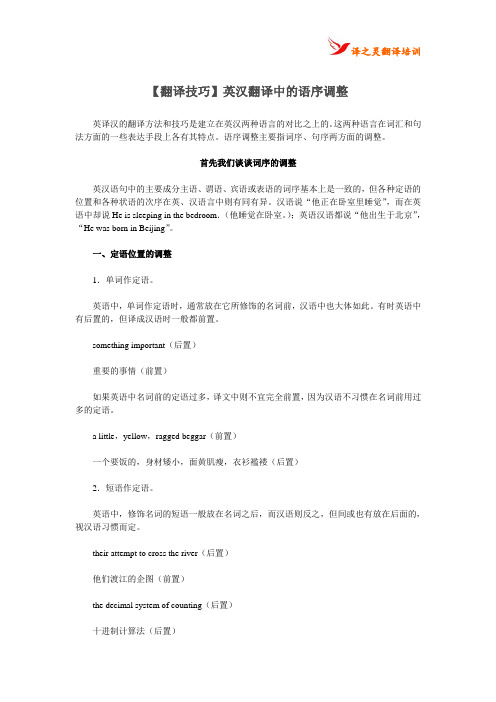
【翻译技巧】英汉翻译中的语序调整英译汉的翻译方法和技巧是建立在英汉两种语言的对比之上的。
这两种语言在词汇和句法方面的一些表达手段上各有其特点。
语序调整主要指词序、句序两方面的调整。
首先我们谈谈词序的调整英汉语句中的主要成分主语、谓语、宾语或表语的词序基本上是一致的,但各种定语的位置和各种状语的次序在英、汉语言中则有同有异。
汉语说“他正在卧室里睡觉”,而在英语中却说He is sleeping in the bedroom.(他睡觉在卧室。
);英语汉语都说“他出生于北京”,“He was born in Beijing”。
一、定语位置的调整1.单词作定语。
英语中,单词作定语时,通常放在它所修饰的名词前,汉语中也大体如此。
有时英语中有后置的,但译成汉语时一般都前置。
something important(后置)重要的事情(前置)如果英语中名词前的定语过多,译文中则不宜完全前置,因为汉语不习惯在名词前用过多的定语。
a little,yellow,ragged beggar(前置)一个要饭的,身材矮小,面黄肌瘦,衣衫褴褛(后置)2.短语作定语。
英语中,修饰名词的短语一般放在名词之后,而汉语则反之,但间或也有放在后面的,视汉语习惯而定。
their attempt to cross the river(后置)他们渡江的企图(前置)the decimal system of counting(后置)十进制计算法(后置)二、状语位置的调整1.单词作状语。
英语中单词作状语修饰形容词或其他状语时,通常放在它所修饰的形容词或状语的前面,这一点与汉语相同。
He was very active in class.(前置)他在班上很活跃。
(前置)英语中单词作状语修饰动词时,一般放在动词之后,而在汉语里则放在动词之前。
Modern science and technology are developing rapidly.(后置)现代科学技术正在迅速发展。
汉英翻译技巧语序变换
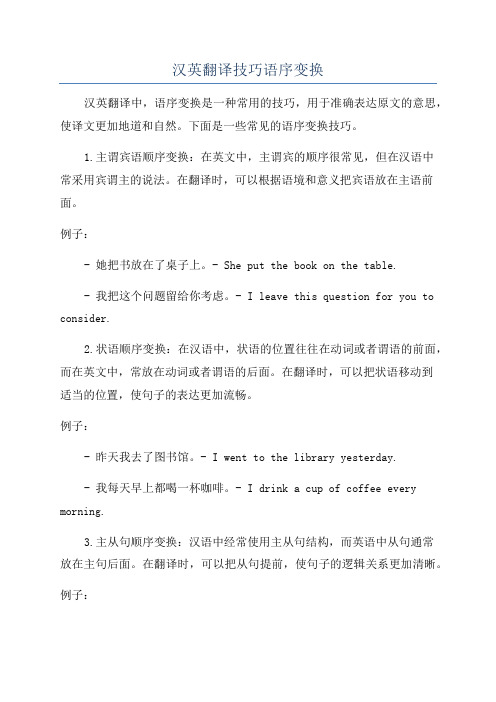
汉英翻译技巧语序变换汉英翻译中,语序变换是一种常用的技巧,用于准确表达原文的意思,使译文更加地道和自然。
下面是一些常见的语序变换技巧。
1.主谓宾语顺序变换:在英文中,主谓宾的顺序很常见,但在汉语中常采用宾谓主的说法。
在翻译时,可以根据语境和意义把宾语放在主语前面。
例子:- 她把书放在了桌子上。
- She put the book on the table.- 我把这个问题留给你考虑。
- I leave this question for you to consider.2.状语顺序变换:在汉语中,状语的位置往往在动词或者谓语的前面,而在英文中,常放在动词或者谓语的后面。
在翻译时,可以把状语移动到适当的位置,使句子的表达更加流畅。
例子:- 昨天我去了图书馆。
- I went to the library yesterday.- 我每天早上都喝一杯咖啡。
- I drink a cup of coffee every morning.3.主从句顺序变换:汉语中经常使用主从句结构,而英语中从句通常放在主句后面。
在翻译时,可以把从句提前,使句子的逻辑关系更加清晰。
例子:- 我喜欢看书,因为它可以让我放松。
- I like reading books because it helps me relax.4.形容词顺序变换:在英语中,形容词的顺序通常是:大小、形状、年龄、颜色、国籍、材料、目的/用途等。
在翻译时,可以调整形容词的顺序,使之符合英语的表达习惯。
例子:- 一只小黑狗。
- A small black dog.- 我买了一件红色的新衣服。
- I bought a new red shirt.5.强调结构顺序变换:在英语中,强调结构通常是通过在句子中使用特殊的强调词或者重音来实现的。
在翻译时,可以根据强调的内容和语境,调整句子的语序,使之突出强调的部分。
例子:- 他不是我的朋友,是我的老师。
- He is not my friend, but my teacher.- 这本书他居然会忘记还给我。
翻译技巧--语序调整
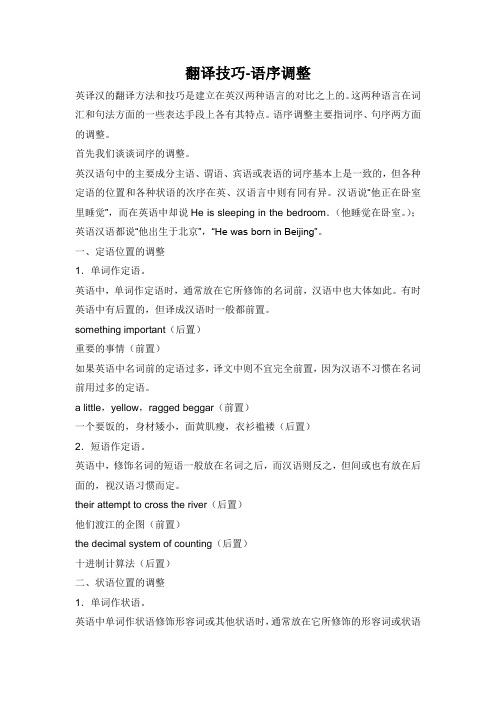
翻译技巧-语序调整英译汉的翻译方法和技巧是建立在英汉两种语言的对比之上的。
这两种语言在词汇和句法方面的一些表达手段上各有其特点。
语序调整主要指词序、句序两方面的调整。
首先我们谈谈词序的调整。
英汉语句中的主要成分主语、谓语、宾语或表语的词序基本上是一致的,但各种定语的位置和各种状语的次序在英、汉语言中则有同有异。
汉语说“他正在卧室里睡觉”,而在英语中却说He is sleeping in the bedroom.(他睡觉在卧室。
);英语汉语都说“他出生于北京”,“He was born in Beijing”。
一、定语位置的调整1.单词作定语。
英语中,单词作定语时,通常放在它所修饰的名词前,汉语中也大体如此。
有时英语中有后置的,但译成汉语时一般都前置。
something important(后置)重要的事情(前置)如果英语中名词前的定语过多,译文中则不宜完全前置,因为汉语不习惯在名词前用过多的定语。
a little,yellow,ragged beggar(前置)一个要饭的,身材矮小,面黄肌瘦,衣衫褴褛(后置)2.短语作定语。
英语中,修饰名词的短语一般放在名词之后,而汉语则反之,但间或也有放在后面的,视汉语习惯而定。
their attempt to cross the river(后置)他们渡江的企图(前置)the decimal system of counting(后置)十进制计算法(后置)二、状语位置的调整1.单词作状语。
英语中单词作状语修饰形容词或其他状语时,通常放在它所修饰的形容词或状语的前面,这一点与汉语相同。
He was very active in class.(前置)他在班上很活跃。
(前置)英语中单词作状语修饰动词时,一般放在动词之后,而在汉语里则放在动词之前。
Modern science and technology are developing rapidly.(后置)现代科学技术正在迅速发展。
翻译技巧里的顺序调整法

翻译技巧里的顺序调整法
顺序调整法是一种常用的翻译技巧,可以提高翻译质量和效率。
具体步骤如下:
1. 阅读原文全文,把握大意;
2. 逐句分析原文,确定语法结构和单词含义;
3. 根据译文的语言习惯、表达方式、语体风格等因素,调整原文中词句的顺序;
4. 再次检查整篇译文,确保表达准确,语序自然、流畅。
顺序调整法的核心思想是“词序逆转”。
翻译中常常存在原文与目标语相反的语序,这时可以通过调整词序来实现更好的翻译效果。
具体来说,可以采用以下几种调整方式:
1. 主谓宾的调整:将原文中的主语与谓语、宾语调整位置,使句子更符合目标语的语法结构;
2. 时间顺序的调整:根据目标语的时间顺序,调整原文中的词语顺序,使其更符合目标语的表达方式;
3. 修饰语位置的调整:将原文中的修饰语与被修饰的词语调整位置,使译文更加清晰易懂;
4. 倒装语序的应用:在需要强调的情况下,可以使用倒装语序,调整原文和目标语之间的词序差异。
顺序调整法需要翻译者具备一定的语言功底和逻辑思维能力,灵活运用不同的调
整方式,才能实现翻译的精准性和自然性。
常用翻译技巧——语序调整

例5. Read, then, the following essay which undertakes to demonstrate that logic, far from being a dry, pedantic (迂腐)discipline, is a living, breathing thing, full of beauty and passion.【主次】 下面这篇散文,说明逻辑学一点都不枯燥迂腐, 反而清新活泼,富于美感和激情。诸位不妨一 读。【次主】 Jerry说:essay不一定是散文,就是文章。况 且散文怎么好跟逻辑学联系在一起。
home.
调整语序:离开家之前我扫了地,关了窗,
断了电。
顺译:我扫了地,关了窗,断了电,然后才出门。
12 12
12 9
12
10
例5. Read, then, the following essay which undertakes to demonstrate that logic, far from being a dry, pedantic (迂腐)discipline, is a living, breathing thing, full of beauty and passion.
Jerry说:其实这个例句不调整语序也可以翻 的很好。
读了下面这篇文章你就会发现逻辑学不仅不 枯燥迂腐,反而清新活泼,富于美感和激情。
12 11
实战练习 I swept the floor, closed the window and
cut the electricity the door before leaving
12Байду номын сангаас
7
英语翻译技巧逐步突破之语序调整法

、
调序调整
解 析  ̄ pdy修饰 “ e e pn ” 翻译 时需 要放 在它 的 r il a d v l ig , o 前 面。
大到小 。词序的调整不仅仅只有 以上几种 , 想提醒大家的是 . 词序的调整是一种很重要的翻译技巧和手段 。要不断地实践 并且逐步掌握这种技巧 , 以提高 自己的翻译水平。例如:
● i o
考 …… 伎薹
T ec lg a uln a er e 0 0 ( 点 在 h ol ew sb i e rt i ri 2 0 .地 e t h v n
英 、 语言 中句子 的主要 成分 主语 、 汉 谓语 、 或表 语 宾语 的语序基 本上是一致 的 ,但各种定语 的位置 和各种状语 的 次序在英 、 汉语 言 中则有 异有 同。汉语说 :他正 在卧室 睡 “ 觉” 而在英语 中却说 Hei s e igi eb do m.他 睡 , l pn t e r o ( se nh
回 来。
前 , 间在 后) 时
2 2英 、 . 汉语 复合句 中逻辑顺序 的调整技巧
这所 大学于 2 0 0 0年建设 在一条 小河 旁。( 间在前 , 时 地
点在后 )
英 、汉语 复合句 中时 间顺 序 的调整 主要包 括 以下 三种
情况, 归纳总结 如下 :
解析 :翻译成 英文 时 i 0 0在 n a er e 之 后 . n2 0 e rh vr t i
To g tsa td,cik o “ i l r e a e’ n t e e tre l n S mpe O d rP g ’o c h
(完整版)翻译中的语序调整
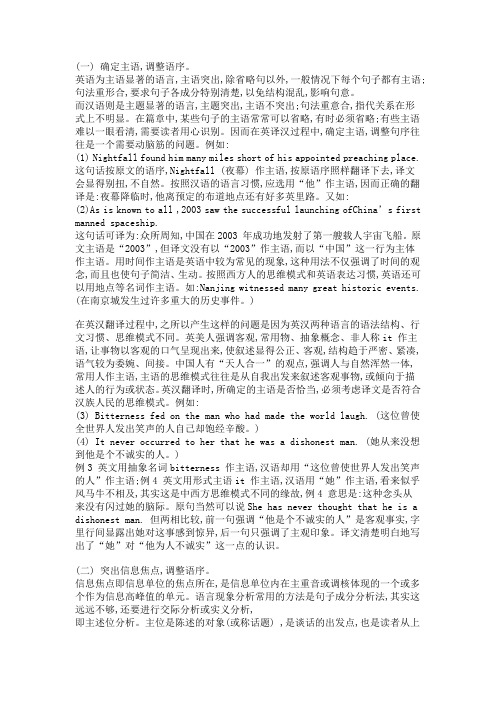
(一) 确定主语,调整语序。
英语为主语显著的语言,主语突出,除省略句以外,一般情况下每个句子都有主语;句法重形合,要求句子各成分特别清楚,以免结构混乱,影响句意。
而汉语则是主题显著的语言,主题突出,主语不突出;句法重意合,指代关系在形式上不明显。
在篇章中,某些句子的主语常常可以省略,有时必须省略;有些主语难以一眼看清,需要读者用心识别。
因而在英译汉过程中,确定主语,调整句序往往是一个需要动脑筋的问题。
例如:(1) Nightfall found him many miles short of his appointed preaching place. 这句话按原文的语序,Nightfall (夜幕) 作主语,按原语序照样翻译下去,译文会显得别扭,不自然。
按照汉语的语言习惯,应选用“他”作主语,因而正确的翻译是:夜幕降临时,他离预定的布道地点还有好多英里路。
又如:(2)As is known to all ,2003 saw the successful launching ofChina’s first manned spaceship.这句话可译为:众所周知,中国在2003 年成功地发射了第一艘载人宇宙飞船。
原文主语是“2003”,但译文没有以“2003”作主语,而以“中国”这一行为主体作主语。
用时间作主语是英语中较为常见的现象,这种用法不仅强调了时间的观念,而且也使句子简洁、生动。
按照西方人的思维模式和英语表达习惯,英语还可以用地点等名词作主语。
如:Nanjing witnessed many great historic events. (在南京城发生过许多重大的历史事件。
)在英汉翻译过程中,之所以产生这样的问题是因为英汉两种语言的语法结构、行文习惯、思维模式不同。
英美人强调客观,常用物、抽象概念、非人称it 作主语,让事物以客观的口气呈现出来,使叙述显得公正、客观,结构趋于严密、紧凑,语气较为委婉、间接。
翻译技巧之语序调整法
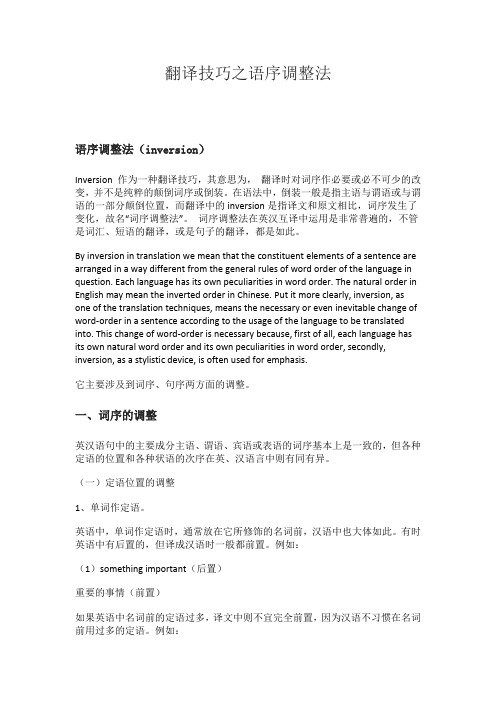
翻译技巧之语序调整法语序调整法(inversion)Inversion 作为一种翻译技巧,其意思为,翻译时对词序作必要或必不可少的改变,并不是纯粹的颠倒词序或倒装。
在语法中,倒装一般是指主语与谓语或与谓语的一部分颠倒位置,而翻译中的inversion是指译文和原文相比,词序发生了变化,故名“词序调整法”。
词序调整法在英汉互译中运用是非常普遍的,不管是词汇、短语的翻译,或是句子的翻译,都是如此。
By inversion in translation we mean that the constituent elements of a sentence are arranged in a way different from the general rules of word order of the language in question. Each language has its own peculiarities in word order. The natural order in English may mean the inverted order in Chinese. Put it more clearly, inversion, as one of the translation techniques, means the necessary or even inevitable change of word-order in a sentence according to the usage of the language to be translated into. This change of word-order is necessary because, first of all, each language has its own natural word order and its own peculiarities in word order, secondly, inversion, as a stylistic device, is often used for emphasis.它主要涉及到词序、句序两方面的调整。
汉英翻译技巧语序变换

汉英翻译技巧语序变换在进行汉英翻译时,语序变换是一种常用的翻译技巧,可以有效地提高翻译质量和准确度。
语序变换可以根据不同的语言结构和表达习惯,将句子的语序重新调整,使译文更加自然流畅。
下面将介绍一些常用的汉英翻译技巧和语序变换的方法。
1.主谓宾语语序变换在英语中,主语通常位于句子的前面,而宾语位于动词之后。
而在汉语中,主谓宾语的语序通常是主语+谓语+宾语的形式。
因此,在进行翻译时,可以根据句子的语序将主语移到谓语之前,宾语置于动词之后。
例如:汉语句子:“我喜欢吃苹果。
”英语翻译:“I like eating apples.”2.定语语序变换在汉语中,定语通常位于被修饰词之前,而在英语中,定语通常位于被修饰词之后。
在进行翻译时,可以将定语移到被修饰词之后,使译文更加符合英语的表达习惯。
例如:汉语句子:“他有一头黑色的长发。
”英语翻译:“He has long black hair.”3.状语语序变换在汉语中,状语通常位于句子的后面,而在英语中,状语通常位于句子的前面或句子的特定位置。
因此,在进行翻译时,可以将状语移到句子的前面或特定位置,使译文更符合英语的表达习惯。
例如:汉语句子:“昨天我去了图书馆。
”英语翻译:“Yesterday I went to the library.”4.倒装语序变换在一些特定的语法结构中,英语中的句子语序需要进行倒装。
在进行翻译时,可以根据情况将句子的语序进行倒装,使译文更准确地表达原文的意思。
例如:汉语句子:“只有努力学习,才能取得好成绩。
”英语翻译:“Only by studying hard can we achieve good results.”5.选择适当的连词在进行语序变换时,有时需要选择适当的连词来引导从句或连接句子。
常用的连词有并列连词(and, but, or, so)、条件连词(if, unless)、原因连词(because, since)、目的连词(in order to, so that)等。
英语翻译技巧中的语序调整法探析
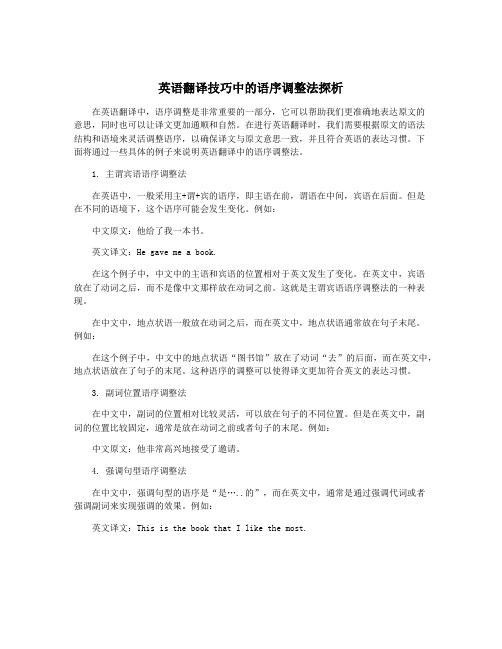
英语翻译技巧中的语序调整法探析在英语翻译中,语序调整是非常重要的一部分,它可以帮助我们更准确地表达原文的意思,同时也可以让译文更加通顺和自然。
在进行英语翻译时,我们需要根据原文的语法结构和语境来灵活调整语序,以确保译文与原文意思一致,并且符合英语的表达习惯。
下面将通过一些具体的例子来说明英语翻译中的语序调整法。
1. 主谓宾语语序调整法在英语中,一般采用主+谓+宾的语序,即主语在前,谓语在中间,宾语在后面。
但是在不同的语境下,这个语序可能会发生变化。
例如:中文原文:他给了我一本书。
英文译文:He gave me a book.在这个例子中,中文中的主语和宾语的位置相对于英文发生了变化。
在英文中,宾语放在了动词之后,而不是像中文那样放在动词之前。
这就是主谓宾语语序调整法的一种表现。
在中文中,地点状语一般放在动词之后,而在英文中,地点状语通常放在句子末尾。
例如:在这个例子中,中文中的地点状语“图书馆”放在了动词“去”的后面,而在英文中,地点状语放在了句子的末尾。
这种语序的调整可以使得译文更加符合英文的表达习惯。
3. 副词位置语序调整法在中文中,副词的位置相对比较灵活,可以放在句子的不同位置。
但是在英文中,副词的位置比较固定,通常是放在动词之前或者句子的末尾。
例如:中文原文:他非常高兴地接受了邀请。
4. 强调句型语序调整法在中文中,强调句型的语序是“是…..的”,而在英文中,通常是通过强调代词或者强调副词来实现强调的效果。
例如:英文译文:This is the book that I like the most.。
汉英翻译技巧语序变换

2.通常作表语用的形容词,用作定语时必须后置 例如:
(1)他是当今最伟大的诗人。 He is the greatest poet alive. (2) 到场的来宾中有一些外国记者。 The guests present included a few foreign newsmen. (3) 仅这个委员会就有三名女委员。 On this committee alone there are three women.
offered. (2) 那些唱歌的人大部分是妇女。 Most of the people singing were women. (3) 他要求有关人员都积极参加这项工作。 He urged those concerned to take an active part in
the work.
汉英翻译技巧 语序变换
一、定语位置的变换
二、状语位置的变换
三、其他句子成分和词语位置的变 换
汉译英时,对原文的句子成分和词语的先 后顺序,必须按照英语的词序习惯重新安 排,而不可照搬。原文中的某一语序在译 文中变换成另一种语序,这就叫做语序的 变换。
汉语和英语的词序有时也有相同之处。 遇到这种情况,翻译时可按原文语序排列 句子成分,这里无需赘述,下面举例说明 语序相异时如何进行语序变换的几种情况。
(2) 这是能想得到的最好解决办法。
This is the best solution imaginable.
5.某些分词用作定语时,也须后置。例如: (1)他们收下了赠送的礼物,十分高兴。 They were very glad to have accepted the presents
4.某些以-ible 或-able 结尾的形容词用作定语, 与every, the only, 或形容词最高级连用来修饰一 个名词的,也常放在所修饰的名词之后。例如:
中译英语序调整法
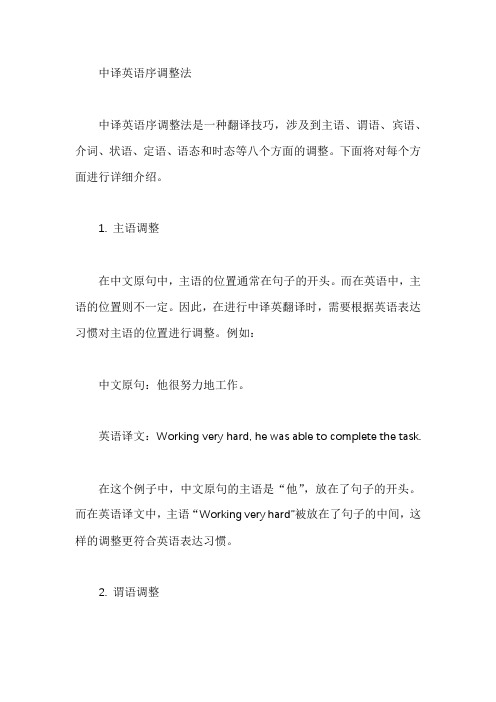
中译英语序调整法中译英语序调整法是一种翻译技巧,涉及到主语、谓语、宾语、介词、状语、定语、语态和时态等八个方面的调整。
下面将对每个方面进行详细介绍。
1. 主语调整在中文原句中,主语的位置通常在句子的开头。
而在英语中,主语的位置则不一定。
因此,在进行中译英翻译时,需要根据英语表达习惯对主语的位置进行调整。
例如:中文原句:他很努力地工作。
英语译文:Working very hard, he was able to complete the task.在这个例子中,中文原句的主语是“他”,放在了句子的开头。
而在英语译文中,主语“Working very hard”被放在了句子的中间,这样的调整更符合英语表达习惯。
2. 谓语调整在中文原句中,谓语的位置通常紧随主语之后。
而在英语中,谓语的位置则不一定。
因此,在进行中译英翻译时,需要根据英语表达习惯对谓语的位置进行调整。
例如:中文原句:他喜欢看电影。
英语译文:He enjoys watching movies.在这个例子中,中文原句的谓语是“喜欢”,放在了主语“他”之后。
而在英语译文中,谓语“enjoys”放在了主语“He”的前面,这样的调整更符合英语表达习惯。
3. 宾语调整在中文原句中,宾语的位置通常在谓语之后。
而在英语中,宾语的位置则不一定。
因此,在进行中译英翻译时,需要根据英语表达习惯对宾语的位置进行调整。
例如:中文原句:我看了一本书。
英语译文:I read a book.在这个例子中,中文原句的宾语是“一本书”,放在了谓语“看”之后。
而在英语译文中,宾语“a book”放在了谓语“read”的前面,这样的调整更符合英语表达习惯。
4. 介词调整在中文原句中,介词的位置通常在宾语之前。
而在英语中,介词的位置则不一定。
因此,在进行中译英翻译时,需要根据英语表达习惯对介词的位置进行调整。
例如:中文原句:我在学校学习。
英语译文:I study at school.在这个例子中,中文原句的介词是“在”,放在了宾语“学校”之前。
- 1、下载文档前请自行甄别文档内容的完整性,平台不提供额外的编辑、内容补充、找答案等附加服务。
- 2、"仅部分预览"的文档,不可在线预览部分如存在完整性等问题,可反馈申请退款(可完整预览的文档不适用该条件!)。
- 3、如文档侵犯您的权益,请联系客服反馈,我们会尽快为您处理(人工客服工作时间:9:00-18:30)。
翻译技巧之语序调整法
语序调整法(inversion)
Inversion 作为一种翻译技巧,其意思为,翻译时对词序作必要或必不可少的改变,并不是纯粹的颠倒词序或倒装。
在语法中,倒装一般是指主语与谓语或与谓语的一部分颠倒位置,而翻译中的inversion是指译文和原文相比,词序发生了变化,故名“词序调整法”。
词序调整法在英汉互译中运用是非常普遍的,不管是词汇、短语的翻译,或是句子的翻译,都是如此。
By inversion in translation we mean that the constituent elements of a sentence are arranged in a way different from the general rules of word order of the language in question. Each language has its own peculiarities in word order. The natural order in English may mean the inverted order in Chinese. Put it more clearly, inversion, as one of the translation techniques, means the necessary or even inevitable change of word-order in a sentence according to the usage of the language to be translated into. This change of word-order is necessary because, first of all, each language has its own natural word order and its own peculiarities in word order, secondly, inversion, as a stylistic device, is often used for emphasis.
它主要涉及到词序、句序两方面的调整。
一、词序的调整
英汉语句中的主要成分主语、谓语、宾语或表语的词序基本上是一致的,但各种定语的位置和各种状语的次序在英、汉语言中则有同有异。
(一)定语位置的调整
1、单词作定语。
英语中,单词作定语时,通常放在它所修饰的名词前,汉语中也大体如此。
有时英语中有后置的,但译成汉语时一般都前置。
例如:
(1)something important(后置)
重要的事情(前置)
如果英语中名词前的定语过多,译文中则不宜完全前置,因为汉语不习惯在名词前用过多的定语。
例如:。
